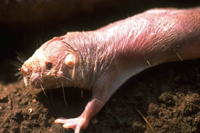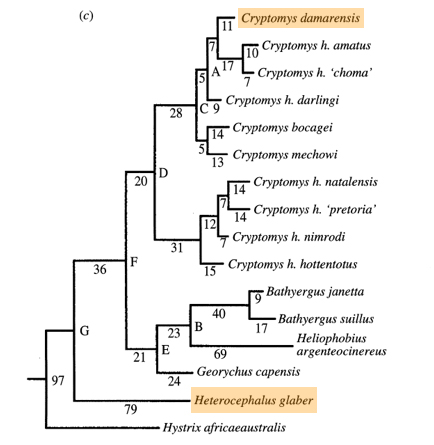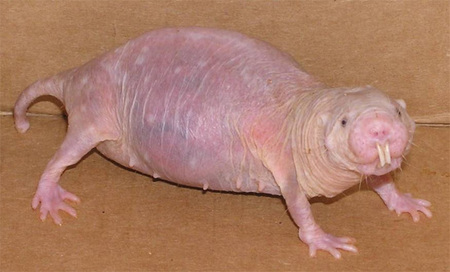 Eusociality in Naked Mole-Rats
Eusociality in Naked Mole-Rats
Biology 342 - Fall 2010
Isabel Cylinder & Quinn Amacher
Phylogeny
What is Phylogeny?
Phylogeny is defined as "the development or evolution of a particular group of organisms“ (21). In this case, however, we will examine the phylogeny (that is, the development or evolution) of a particular behavior, specifically eusocial behavior in naked mole-rats.
Phylogeny of H. glaber

A phylogenetic tree for African mole-rats (family Bathyergidae) and one outgroup species (H. africaeaustralis). The numbers below the branches indicate branch length. This tree shows that H. glaber evolved divergently from the rest of the African mole-rats at an early stage. (10)
The naked mole-rat and the Damaraland mole-rat (Cryptomys damarensis) are currently the only eusocial vertebrates recognized (though some have argued that the entire Cryptomys genus can be considered eusocial (4)), and the behavior is believed to be the result of convergent evolution (10). There has been no conclusive evidence as to whether the common ancestor of these two eusocial species was also eusocial or if it was solitary. Initially, eusociality was believed to have evolved because of the high rate of inbreeding in H. glaber, but when C. damarensis was found to avoid inbreeding and instead favor dispersal and outbreeding, this theory was dismissed (10).
One well-known hypothesis for the evolution of eusociality in mole-rats is the Aridity Food-Distribution Hypothesis (or AFDH). Essentially, this hypothesis states that larger colony size benefits the naked mole-rat because the low amount of rainfall and sparse distribution of available food in its environment makes seeking food in a solitary manner almost impossible. See Adaptive Value for more information on this hypothesis.
According to Burda et al. (who argue against the AFDH), “eusociality in mole-rats evolved from a monogamous mating system where cooperative brood care was already established” (22, p. 293). For some time, it was believed that haplodiploidy (a system in which females develop from diploid eggs and males from haploid eggs) was the root of the evolution of eusociality in H. glaber, but it has since been proven neither a necessary nor a sufficient hypothesis (22). For those that oppose the AFDH, the current conclusion is that eusociality in naked mole-rats evolved by way of “… gradual metamorphosis, subsociality (extensive parental care), and life in long-lasting, expansible niches (nests or microhabitats) safe from predators and rich with food that does not require exiting the safety of the niche to obtain it” (22, p. 42).

An adult female naked mole-rat. (B)